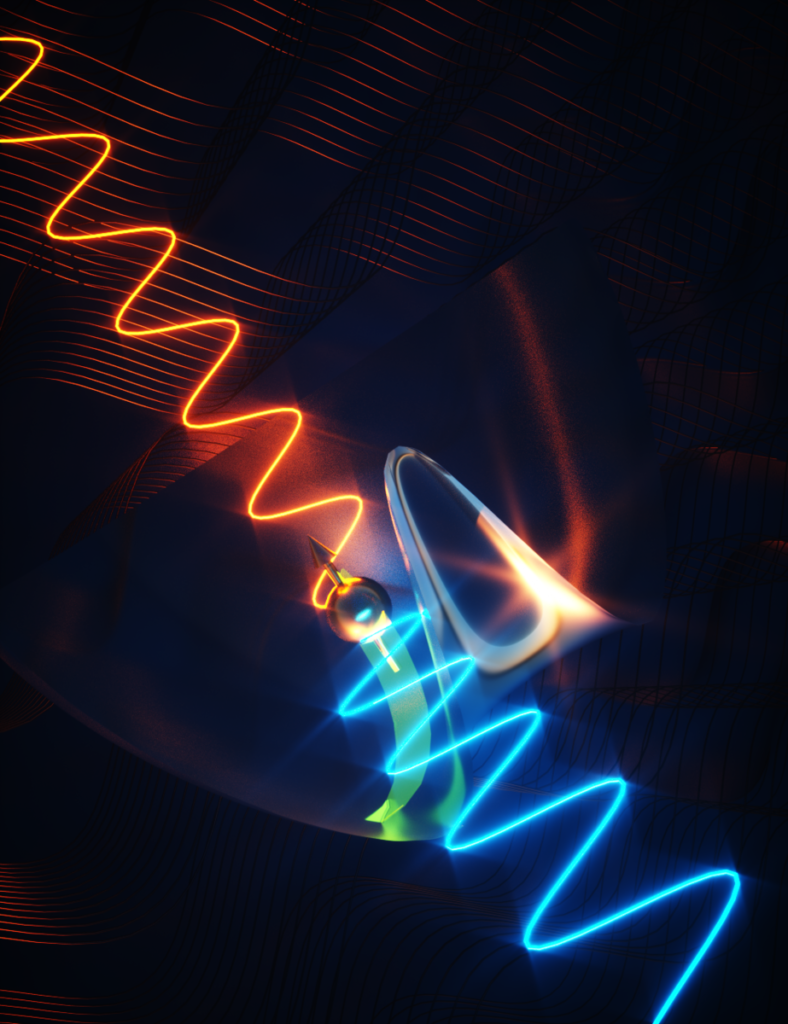Schoop Lab material is key to first observation of new quasi-particle
A material investigated and promoted by the Schoop Lab lies at the heart of the discovery of a new quasi-particle announced in Nature last month.
The research team, which includes Princeton Chemistry, reported the first observation ever of an axial Higgs mode during experiments with a rare-earth telluride, gadolinium tritelluride (GdTe3), a two-dimensional quantum material the Schoop Lab has been exploring for years now.
The research revealed that the charge density wave (CDW) phase in the crystal structure of the material has an exotic-order parameter.

The image shows the charge density wave in the background and, in the front, the energy landscape (like a ball rolling on a hill) that defines the properties of the charge density wave.
The quasi-particle was first predicted in high energy physics as a possible explanation of Dark Matter, a hypothetical form of matter believed to comprise 85% of the matter in the universe. The Schoop material acts like a quantum simulator in that it mimics many of the properties of this theory to reveal the first axial Higgs mode.
“In this case, it’s almost like the universe lives in a crystal. While, of course, a crystal can’t host a real particle, gaining understanding about quasi-particles that live in crystals gives us important information about what can be hidden out there in the universe,” said Leslie Schoop, associate professor of chemistry. “That’s the beauty of condensed matter physics. A big part of it is trying to understand the world and how it’s made.”
An axial Higgs mode manifests as a quantum excitation in tellurides, a class of quantum materials known for exhibiting CDW interactions. To measure the mode, researchers exploited the quantum pathway using a technique known as Raman spectroscopy. By sending light in one direction at the crystal and measuring its scattering effect, researchers were able to observe the presence of the axial Higgs.
Compounding the unusual circumstances surrounding the discovery, the experiment was performed on a lab tabletop at room temperature. The observation of new particles is typically associated with extreme conditions.
The discovery was reported in Nature on June 8.
Led by researchers from Boston College, the team included Princeton, Harvard, Yale, and the University of Washington.
“The detection of the axial Higgs was predicted in high-energy particle physics to explain Dark Matter. However, it has never been observed before,” said Kenneth Burch, professor of physics at Boston College and the team’s P.I. “Its appearance in a condensed matter system was completely surprising and heralds the discovery of a new broken symmetry state that had not been predicted.
“Moreover, our approach can be straightforwardly applied to the quantum properties of numerous collective phenomena,” Burch added, “including modes in superconductors, magnets, ferroelectrics, and charge density waves.”
Material “crucial” to discovery
Burch said the material provided by the Schoop Lab was “crucial” to the discovery. It contained the right combination of properties to create the mode and to allow for its observation.

An image of gadolinium tritelluride (GdTe3), the material at the heart of the discovery of a new quasi-particle.
Originally, researchers were interested in GdTe3 because it can be exfoliated down to thin layers, is magnetic, and has excellent electronic transport. These properties were first reported in a paper Schoop published in Science Advances in 2020. The team did not intend to look at the charge density wave at the time.
But the unconventional light scattering response during spectroscopy led the team to take a closer look. That response was ultimately identified as proof of the axial Higgs mode in the system.
The Schoop lab has been interested in so-called “square-net” materials for years, as in a paper published in Advanced Materials last June. The square-net arrangement of atoms is key to many of the exotic properties in such materials, including the axial Higgs mode.
“When we accomplished that first paper [on this material] in 2020, we reached out to Ken to see if he wanted to study the optical effects. I knew it had to have important and interesting physical properties because of its square net. I went to Ken because I cannot do the kinds of measurements needed,” said Schoop. “And basically, we found that there’s actually much more cool stuff hidden in the material.
“With every paper that proves that square-net materials indeed host exotic properties, I’m getting more and more excited,” Schoop added, “because I think we’ve found a gold mine with these materials that we can exploit.”
“Axial Higgs mode detected by quantum pathway interference in RTe3,” was published in the June 8, 2022 edition of Nature. Funding was supported by a grant from the Air Force Office of Scientific Research under award number FA9550-20-1-0246. Schoop acknowledges support from the Gordon and Betty Moore Foundation (EPiQS Synthesis Award) through grant GBMF9064, the David and Lucile Packard Foundation, and the Sloan Foundation.
